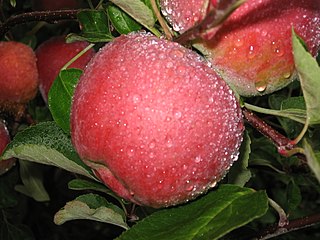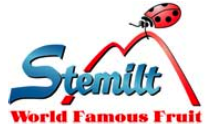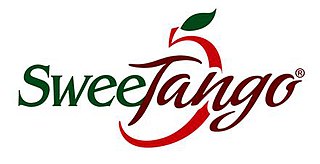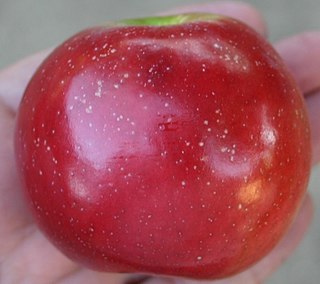
Golden Delicious is a cultivar of apple. It is one of the 15 most popular apple cultivars in the United States. It is not closely related to Red Delicious.

Red Delicious is a type of apple with a red exterior and sweet taste that was first recognized in Madison County, Iowa, in 1872. Today, the name Red Delicious comprises more than 50 cultivars. It was the most produced cultivar in the United States from 1968 to 2018, when it was surpassed by Gala.

The Haralson is a cultivar of apple that is medium-sized and has a round-conic shape.

Honeycrisp is an apple cultivar developed at the Minnesota Agricultural Experiment Station's Horticultural Research Center at the University of Minnesota, Twin Cities. Designated in 1974 with the MN 1711 test designation, patented in 1988, and released in 1991, the Honeycrisp, once slated to be discarded, has rapidly become a prized commercial commodity, as its sweetness, firmness, and tartness make it an ideal apple for eating raw. "...The apple wasn't bred to grow, store or ship well. It was bred for taste: crisp, with balanced sweetness and acidity." It has larger cells than most apple cultivars, a trait which is correlated with juiciness, as theoretically a higher number of cells rupture when bitten, releasing more juice in the mouth. The Honeycrisp also retains its pigment well and has a relatively long shelf life when stored in cool, dry conditions. Pepin Heights Orchards delivered the first Honeycrisp apples to grocery stores in 1997. The name Honeycrisp was trademarked by the University of Minnesota, but university officials were unsure of its protection status in 2007. It is now the official state fruit of Minnesota. A large-sized honeycrisp will contain about 113 calories.

The 'Pink Pearl' apple is a pink-fleshed apple cultivar developed in 1944 by Albert Etter, a northern California breeder. It is a seedling of 'Surprise', another pink-fleshed apple that is believed to be a descendant of Malus niedzwetskyana.

'Macoun' apples are a cross between the 'McIntosh' and 'Jersey Black' cultivars. The Macoun was developed at the New York State Agricultural Experiment Station in Geneva, by Richard Wellington. It was first introduced in 1932, and is an eating apple. This apple is excellent for making European style apple pies because it doesn't break down during cooking and remains firm. Macouns are also very popular at roadside stands and pick-your-own farms. Availability is generally October through November. Sugar 13%, acid 6g/litre, vitamin C 4mg/100g.

The Cornish Gilliflower is a cultivar of apple.

Cripps Pink is a cultivar of apple. It is one of several cultivars sold under the trade mark name Pink Lady. It was originally bred by John Cripps at the Western Australia Department of Agriculture, by crossing the Australian apple Lady Williams with a Golden Delicious; the result is a combination of the firm, long-storing property of Lady Williams with the sweetness and lack of storage scald of Golden Delicious.

An apple is an edible fruit produced by an apple tree. Apple trees are cultivated worldwide and are the most widely grown species in the genus Malus. The tree originated in Central Asia, where its wild ancestor, Malus sieversii, is still found today. Apples have been grown for thousands of years in Asia and Europe and were brought to North America by European colonists. Apples have religious and mythological significance in many cultures, including Norse, Greek, and European Christian tradition.

The Zestar! apple or Minnewashta (cultivar) is an apple cultivar released in 1999. It was developed by the horticulturalists at the Minnesota Landscape Arboretum's Horticultural Resource Center, at the University of Minnesota.

Stemilt Growers, owned by the Mathison family, is a family-owned tree fruit growing, packing and shipping company based in Wenatchee, Washington. Stemilt is the largest fresh market sweet cherry shipper in the world, and one of the nation's largest grower-packer-shippers of apples, pears, cherries, and stone fruit. Its signature apple varieties include Piñata, Honeycrisp, Gala, and Pink Lady. The company is also a leader in organic fruit production, producing 26% of Washington's organic apples and 32% of the Pacific Northwest's organic pears. In 2008, the company shipped over 20 million boxes of fruit and employed 1,500 people full-time.

SweeTango is the brand name of the cultivated apple 'Minneiska'. It is a cross between the 'Honeycrisp' and the Zestar Apple belonging to the University of Minnesota. The apple is controlled and regulated for marketing, allowing only exclusive territories for growing. It has a sweet-tart taste that some food writers have described as something between brown sugar and spiced apple cider.

The Wealthy is an American apple cultivar, and was the earliest to thrive in the Minnesota climate. Horticulturalist Peter Gideon first grew it in 1868, after years of trial and error with various apple varieties.

The Kentville Research and Development Centre (formerly Atlantic Food and Horticulture Research Centre) is a branch of Agriculture and Agri-Food Canada's national network of 20 research centres stationed across Canada. The site is situated on 464 acres in Kentville, located in Nova Scotia's Annapolis Valley. The Centre's programs address agricultural challenges throughout the Canadian horticultural and food network, but primarily focus on the regional requirements of Atlantic Canada. On September 2, 2003, the centre's staff was recognized by Environment Canada for providing a volunteer climate observation station for a continuous 70 years. On January 26, 2011, and in honour of their centennial celebration, the centre was bestowed with an honorary membership to the Nova Scotia Fruit Growers Association in recognition of the centre's development and support of a sustainable tree fruit industry in Atlantic Canada.

Enterprise is a modern bred, late-ripening and attractive, red cultivar of domesticated apple with excellent fruit quality combined with disease resistance to scab, cedar apple rust, fire blight and some resistance to powdery mildew. The fruit is large and attractive and retains excellent fresh quality for up to six months at 1°C. Its moderate acidity at time of harvest mellows in storage, and it is best after one month of storage.

'Honeygold' is a cold-hardy cultivar of domesticated apple, which was developed to suit for the northern cold areas. It was developed by the Minnesota Agricultural Experiment Station's Horticultural Research Center of the University of Minnesota. They were crossing a Golden Delicious with a Haralson in order to obtain a Golden Delicious style fruit with the cold hardiness of the Haralson, a goal which was successfully achieved.

Cosmic Crisp is an American apple with the variety designation 'WA 38'. Breeding began in 1997 at the Washington State University (WSU) Tree Fruit Research and Extension Center in Wenatchee, Washington, and was initially overseen by Bruce Barritt. Kate Evans stepped in to complete the research after Barritt’s retirement from WSU.

SugarBee (CN121) is an apple cultivar grown in the elevated orchards of Washington state. The variety was discovered by Chuck Nystrom in the early 1990s and developed in Minnesota, and is believed to be a cross-pollination between a Honeycrisp and another unknown variety. Today, SugarBee has worldwide propagation rights held by Regal Fruit International and is licensed to Gebbers Farms and the Chelan Fruit Cooperative in Washington to produce the variety in the United States.

The malinda apple is a cultivar of domesticated apple, originating in New England., most likely Vermont.

EverCrisp is an American apple cultivar developed by the Midwest Apple Improvement Association (MAIA). Trademarked as EverCrisp, the MAIA-1 variety is a cross between two existing apple cultivars: the Honeycrisp and Fuji. Originally produced in Ohio, EverCrisp has since expanded to apple-growing regions across the Midwest in Michigan, Illinois and Indiana, in the Northeast in Pennsylvania and New York, and in the Northwest in Washington. The apple entered the public marketplace in 2017.




















